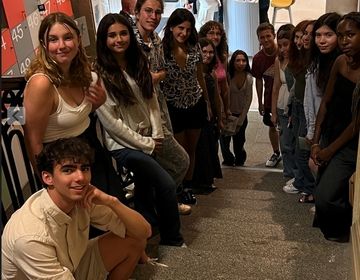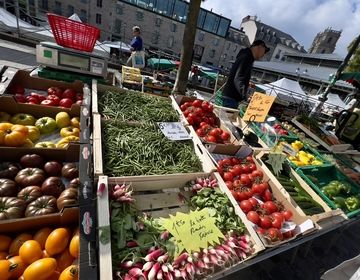Week 2: la vie quotidienne
We’re just ending our second of four weeks here in Rennes, France, where we’ve pretty much gotten into our respective grooves at this point. The navigation of buses and trains now feels routine, our schedules are manageable, and we’re all but immersed in la vie quotidienne, or the daily life, of our French families.
While this comfort has come quickly, it hasn’t necessarily been without some adjustment. A lot of our learning here focuses on the cultural aspects of the homestay experience, and with good reason. I’ve personally noticed quite a few differences both inside of the home and out: inside, we hang our laundry up to dry instead of using a dryer like at home; outside, we always greet neighbors, bus drivers, and store clerks with “bonjour” or “bonsoir;” inside, there’s rarely air conditioning, so temperatures are kept constant with opened or closed windows; outside, we walk in the street with the cars because there often aren’t sidewalks on the cobblestone streets. In any case, this adjustment isn’t necessarily a negative; there’s lots of things I’ll definitely be taking home with me when I leave. For instance, my host family loves visiting small art fairs on the outskirts of town, and taking walks around their neighborhood or nearby sites where nature is in full view. They spend time together outside after dinner, as the weather and late sunset allow for a few extra hours of society. It’s the little things that make France feel foreign, but the big picture is largely the same. My daily routine isn’t drastically different than it would be in the States, which I think has helped us all adjust.
A typical day here starts with waking up around 7. I go through my morning routine as usual, usually eating cereal or a baguette with honey or jam for breakfast before leaving for my bus station. The bus is rarely more than a minute early or late, and I’ve never waited more than three minutes for the train (here called the Metro). I get to the school campus at about 8:45, enough time to say my hellos to friends in other classes before diving into my own. With 48 students in the language intensive program, there are four classes of 11-13, each at a different level of French. The teacher starts each day by asking us if there are any words or phrases we’ve heard from outside of school since we last met that we want to ask her about, and then starts the regularly scheduled coursework. This typically includes videos or images that we discuss as a class that relate to the week’s theme. Week two’s theme was creativity, so we studied different French artists and art forms, ranging from street art to films to music. We take a 20 minute break around 10:30, where me and my classmates usually spend our leftover euro cents to buy thing from the vending machines in the cafeteria and talk. We go back to class for about an hour before lunch at noon, where we have anywhere from 90 minutes to two hours to explore the restaurants of Rennes with the weekly allowance we have for lunch, or our own money if we want that extra crepe.
After lunch, there are a few days each week where we return for another few hours of class. On the remaining days, our travel group of 48 is divided up into three smaller groups of 16, which we join at a set meeting point (usually a Metro station) after lunch for “Into the Community” activities or excursions.
My favorite excursion thus far has been our activity in one of the malls of Rennes, where we explored the shops and boutiques to find out the differences between an American and French shopping center. Most of these activities have to do with immersion into the French culture, as well as the language, which of course we’re using to discuss them. After we finish the activities, there’s a few hours of free time before curfew (8pm on weekdays or 10pm Friday and Saturday) during which I like to go shopping, exploring, or out to a cafe with friends. When I return home, dinner is generally ready around 8:30 or 9, and lasts about an hour or more, including the very French after-dinner conversation. Being in the Brittany region of France means that there are a plethora of local dishes I’ve tried for the first time with my host family, such as les moules, or mussels, served in a salted butter sauce.
After dinner, I’m free to do my homework, check in with friends and family back home in the US, and settle in for my nightly routine. I’ve also been exploring the wonders of French Netflix, since the available titles can vary by country, and watching shows dubbed or subtitled in French keeps me working on improving my language skills even as the day winds down.
So, all in all, as we’ve settled into our new families and new schedules, I think it's safe to say that each and every one of us is learning a lot, at a pace that's right for us. Until next week -- au revoir!
-Sarah T.
Related Posts
It All Sinks In at Mont Saint Michel
This past Saturday, the French Honors group went on an excursion to Normandie, specifically to the culturally important UNESCO site of Mont Saint Michel. Students enjoyed wildflowers and views of... keep reading
Exploring Art Through the Ages: From Graffiti to Masterpieces at the Musée de Beaux Arts de Rennes
After immersing themselves in the vibrant street art of Rennes yesterday, students embarked on a new cultural adventure at the Musée de Beaux Arts de Rennes (Rennes' Museum of Fine... keep reading
Excursion au Marché de Lices
Saturdays in Rennes come alive with the vibrant energy of Le Marché de Lices, an open-air market set on the historic jousting grounds of the Middle Ages. As the second... keep reading



